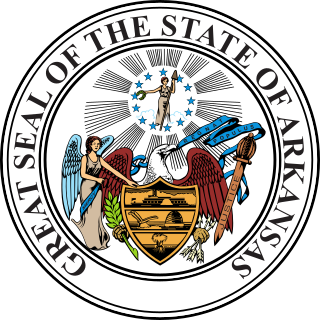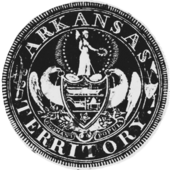
The 15th United States Congress was a meeting of the legislative branch of the United States federal government, consisting of the United States Senate and the United States House of Representatives. It met in the Old Brick Capitol in Washington, D.C. from March 4, 1817, to March 4, 1819, during the first two years of James Monroe's presidency. The apportionment of seats in the House of Representatives was based on the Third Census of the United States in 1810. Both chambers had a Democratic-Republican majority.

Ambrose Hundley Sevier was an attorney, politician and planter from Arkansas. A member of the political Family that dominated the state and national delegations in the antebellum years, he was elected by the legislature as a Democratic US Senator.

The Maryland General Assembly is the state legislature of the U.S. state of Maryland that convenes within the State House in Annapolis. It is a bicameral body: the upper chamber, the Maryland Senate, has 47 representatives and the lower chamber, the Maryland House of Delegates, has 141 representatives. Members of both houses serve four-year terms. Each house elects its own officers, judges the qualifications and election of its own members, establishes rules for the conduct of its business, and may punish or expel its own members.

The Georgia General Assembly is the state legislature of the U.S. state of Georgia. It is bicameral, consisting of the Senate and the House of Representatives.

The North Carolina General Assembly is the bicameral legislature of the State government of North Carolina. The legislature consists of two chambers: the Senate and the House of Representatives. The General Assembly meets in the North Carolina Legislative Building in Raleigh, North Carolina, United States.

The Territory of Wisconsin was an organized incorporated territory of the United States that existed from July 3, 1836, until May 29, 1848, when an eastern portion of the territory was admitted to the Union as the State of Wisconsin. Belmont was initially chosen as the capital of the territory. In 1837, the territorial legislature met in Burlington, just north of the Skunk River on the Mississippi, which became part of the Iowa Territory in 1838. In that year, 1838, the territorial capital of Wisconsin was moved to Madison.
The Delaware Constitution of 1776 was the first governing document for Delaware state government and was in effect from its adoption in September 1776 until its replacement by the 1792 constitution.

The Louisiana State Legislature is the state legislature of the U.S. state of Louisiana. It is a bicameral body, comprising the lower house, the Louisiana House of Representatives with 105 representatives, and the upper house, the Louisiana State Senate with 39 senators. Members of each house are elected from single-member districts of roughly equal populations.

Oregon's Territorial Legislature was a bicameral legislative body created by the United States Congress in 1848 as the legislative branch of the government of the Oregon Territory. The upper chamber Council and lower chamber House of Representatives first met in July 1849; they served as the region's legislative body until Oregon became a state in February 1859, when they were replaced by the bicameral Oregon State Legislature.
The following table indicates the party of elected officials in the U.S. state of Arkansas:

The General Assembly of Arkansas is the state legislature of the U.S. state of Arkansas. The legislature is a bicameral body composed of the upper house Arkansas Senate with 35 members, and the lower Arkansas House of Representatives with 100 members. All 135 representatives and state senators represent an equal number of constituent districts.

The New Jersey Legislative Council was the upper house of the New Jersey Legislature under the New Jersey Constitution of 1776 until it was replaced by the New Jersey Senate under the Constitution of 1844.

The 177th New York State Legislature, consisting of the New York State Senate and the New York State Assembly, met from January 4, 1967, to May 25, 1968, during the ninth and tenth years of Nelson Rockefeller's governorship, in Albany.

The 179th New York State Legislature, consisting of the New York State Senate and the New York State Assembly, met from January 6, 1971, to May 12, 1972, during the thirteenth and fourteenth years of Nelson Rockefeller's governorship, in Albany.

The 180th New York State Legislature, consisting of the New York State Senate and the New York State Assembly, met from January 3, 1973, to May 30, 1974, during the fifteenth and final year of Nelson Rockefeller's governorship, and during Malcolm Wilson's governorship, in Albany.

The 181st New York State Legislature, consisting of the New York State Senate and the New York State Assembly, met from January 8, 1975, to August 5, 1976, during the first and second years of Hugh Carey's governorship in Albany.
The fourth Minnesota Territorial Legislature first convened on January 5, 1853. The 9 members of the Minnesota Territorial Council were elected during the General Election of October 14, 1851, and the 18 members of the Minnesota House of Representatives were elected during the General Election of October 12, 1852.
The 8th Minnesota Territorial Legislature first convened on January 7, 1857. The 15 members of the Minnesota Territorial Council were elected during the General Election of October 9, 1855, and the 38 members of the Minnesota House of Representatives were elected during the General Election of October 14, 1856. The 8th territorial legislature was the final territorial legislature held before the Territory of Minnesota was dissolved and Minnesota was admitted as a state.

The Forty-Eighth Arkansas General Assembly was the legislative body of the state of Arkansas in 1931 and 1932. In this General Assembly, the Arkansas Senate and Arkansas House of Representatives were both controlled by the Democrats. In the Senate, all 35 senators were Democrats, and in the House, 99 representatives were Democrats, with one Republican. It was the first General Assembly to use redistricted legislative districts from the 1930 United States Census.












